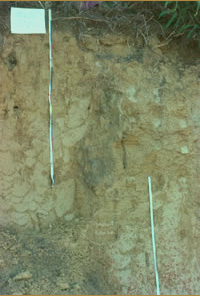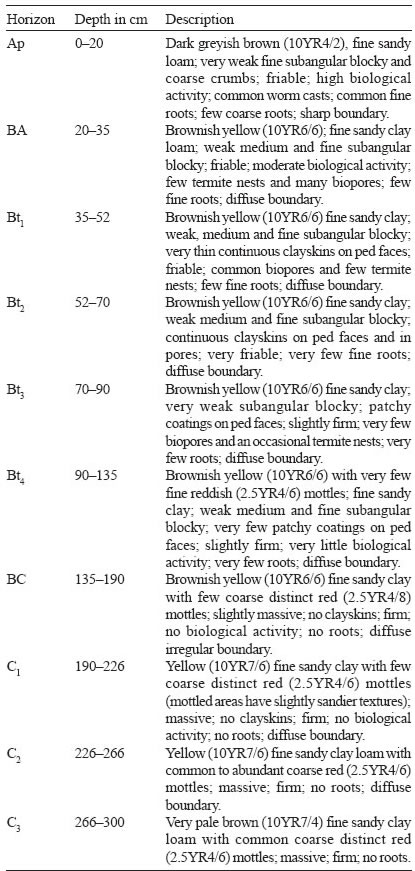Soil Profiles: Bungor
Bungor Series
The Bungor Series is a member of the Bungor Family which is a fine, kaolinitic, isohyperthermic, red-yellow Tipik Lutualemkuts. It typifies the family and is developed over mixed sedimentary rocks. These soils are characterized by dark greyish brown A horizons with fine sandy loam textures and deep B horizons having brownish yellow to yellowish brown colours and fine sandy clay textures. Consistence is friable and becomes firmer with depth. The structures are weak to moderate medium and fine subangular blocky. At depths below 75 cm few medium to coarse distinct red mottles may appear. At depths below 150 cm the colours become paler. This soils is developed over interbedded sandstones and shales or sandy shales. These soils have a kandic horizon and must have a CECclay of less than 16 cmol (+) kg–1 clay in all subhorizons between 25 to 100 cm depth. No significant clay decrease to 100 cm depth is permissible.
Type Location
The Bungor Series was first established on the western part of lower Sungei Lepar Valley in east Pahang by Libby (1964) during the Reconnaissance Soil Survey of Lepar Valley, Pahang. The above pedon was described on a 12° slope in undulating terrain near the village of Sri Jaya at the 37th milestone Kuantan- Temerloh Road. Location: Topographic Sheet 4259, 3°40’20” N, 102°52’40” E (Grid Reference 4259 – 426060 m).
Range in Characteristics
Soils of the Bungor Series show very little variation in the areas mapped to-date. They have colours which range from strong brown, brownish yellow and yellowish brown (7.5YR5/6; 5/8; 10YR5/6, 5/8, 6/6, 6/8). Rarely the colours may be reddish yellow (7.5YR6/6, 6/8). Textures range from fine sandy loam to fine sandy clay loam to clay. Clay contents seldom exceed 50% and fine sand always dominates the coarse sand which seldom exceeds 20%. Structures are weak to moderate medium and fine subangular blocky and consistence friable to firm with depth. Red mottles often appear at depths below 75 cm and increase with depth. The depth of the soil though often deep may sometimes be shallow on steep slopes as they grade into the Kuala Brang and Kuah Series. Some soils of the Bungor Series have a thin band of nodular petroplinthite but the band cannot exceed 25 cm in thickness. As defined here soils of the Bungor Series must have a CECclay of less than 16 cmol (+) kg–1 clay in all subhorizons between 25 to 100 cm depth.
Competing Soils and Their Differences
Soils of the Bungor Series are very similar to soils of the Serdang, Batang Merbau, Munchong Series and Jerangau Series. Both the Munchong and Jerangau Series may have similar colours to the Bungor Series but are heavier textured and have oxic horizons. The distinction between the Bungor Series and the Batang Merbau and Serdang Series is difficult. The Batang Merbau Series has a sand fraction dominated by medium sand while the Bungor Series is dominated by fine sand. The Bungor Series in the field does not show up any coarse sand and even the fine sand is so rounded that it is often not felt. The Serdang Series has fine sandy clay loam textures. The Batang Merbau Series also is reported to have mica flakes throughout the profile as it is developed over mica schists. Some of the Durian Series mapped in the past also may have 7.5YR hues but these have much siltier textures, redder colours at shallow depths, shallower profiles and very firm consistence. The Kuala Brang Series which has many features similar to the Bungor Series is a moderately deep equivalent of the Bungor Series and the saprolite is encountered within 100 cm. Soils of the Bungor Series can be easily mistaken for the Bedup Series (Sarawak) and Kumansi Series/deep (Sabah) or Merit Series (Sarawak) but these soils have a CECclay of more than 16 cmol (+) kg–1 clay in some subhorizon between 25 to 100 cm depth.
Setting
Soils of the Bungor Series are developed over interbedded sandstones and shales or sandy shales. They have been mapped over a wide range of terrain ranging from gently undulating to steep. The commonest range is undulating to hilly.
Principal Associated Soils
Soils of the Bungor Series have often been mapped in association with soils of the Serdang and Munchong Series. The Serdang Series has fine sandy clay loam textures, is more friable and weaker structured than the Bungor Series. The Munchong Series on the other hand is heavy clay textured, more friable and has an oxic horizon. As defined here soils of the Bungor Series may now be associated with soils of the Bedup, Kumansi/deep and Merit Series from which it can be differentiated using the CECclay values.
Drainage and Permeability
Soils of the Bungor Series are well drained and have a good permeability.
Use and Vegetation
Soils of the Bungor Series are commonly planted with a variety of crops including rubber, oil palm, fruit trees, cocoa. Some of these areas are still under primary forest vegetation.
Distribution and Extent
The Bungor Series is fairly well distributed in Peninsular Malaysia. It has been mapped in Perak, Selangor, Negeri Sembilan, Johore, Malacca, Pahang, Terengganu and Kelantan. Their extent is however not known.
Series Established
The soil was established during the Reconnaissance Soil Survey of the Lepar Valley, Northeast Pahang (Libby 1964). The source of name is the village of Paya Bungor on the Kuala Lumpur-Kuantan road.
Remarks on Classification
Soils of the Bungor Series are classified here according to the Malaysian Soil Taxonomy – Second Approximation (Paramananthan 1998) as a member of the fine, kaolinitic, isohyperthermic, red-yellow family of the Tipik Lutualemkuts. They have a deep kandic horizon which has a low base status and in which the clay content does not decrease significantly within 1.0 m of the surface. The CECclay is less than 16 cmol (+) kg–1 clay in all horizons between 25 to 100 cm depth. Soils of the Bungor Series would be classified as Typic Kandiudults in the Keys to Soil Taxonomy – Eighth Edition (Soil Survey Staff 1998). In the FAO/ UNESCO Soil Map of the World – Revised Legend (FAO 1990) they will be classified as Haplic Nitisols.
Suitability for Agriculture
These soils are some of the better sedentary soils found in Peninsular Malaysia. Terrain should be the major limiting factor in these soils. Their fertility status like most soils in this country is low.



